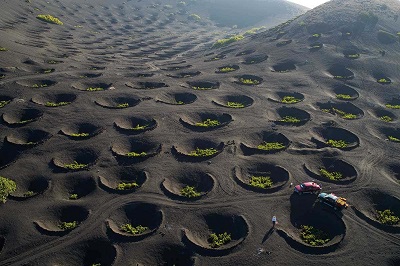 We were delighted to welcome Santo Bains to lead us on an exploration of the wines of the Canary Islands. For many of us a new experience and for those that have already visited the Canary Islands a bit of an eye opener as these high-end wines do not appear to be widely distributed throughout the islands. Even here they are found in niche markets, popular with sommeliers, wanting unusual premium high-end wines on their lists. By all accounts they are exceptionally good value in the Canary Islands and worth seeking out if there on holiday.
We were delighted to welcome Santo Bains to lead us on an exploration of the wines of the Canary Islands. For many of us a new experience and for those that have already visited the Canary Islands a bit of an eye opener as these high-end wines do not appear to be widely distributed throughout the islands. Even here they are found in niche markets, popular with sommeliers, wanting unusual premium high-end wines on their lists. By all accounts they are exceptionally good value in the Canary Islands and worth seeking out if there on holiday.
The wines of the Canary Islands are exceptional in many respects, not least because they are made from a broad portfolio of genetically unique grape varieties which collectively represent one of the best-preserved collections of Vitis vinifera, the Eurasian grapevine. This was lost on the mainland of Europe when phylloxera decimated vineyards worldwide in the late 19th century. Thanks to the Canary Island’s volcanic soils the aphid responsible was unable to breed and so the most important grape variety in the world was spared. Canary Island wines have been 500 years in the making from the island’s discovery, colonisation and settlement, the planting of vines, surviving world wars, market shocks avoiding phylloxera, volcanic eruptions and other catastrophic natural disasters. Vines were planted very soon after the islands were first occupied by Europeans using cultivars brought by settlers from all over Europe particularly Spain and Portugal but also from the eastern Mediterranean. From such a rich genetic ancestry Vitis vinifera developed in new directions as the original plantings were left to adapt and evolve in isolation – new characteristics emerged from natural mutations, environmental pressures, human selection and new varieties created from natural crossbreeding.
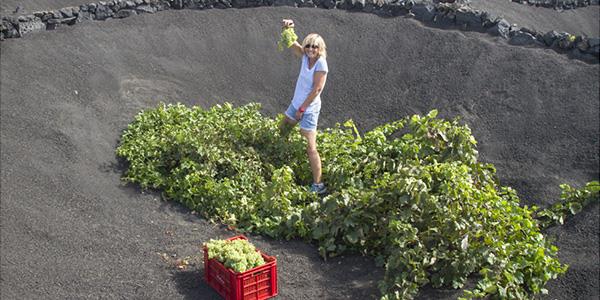 The Canary Islands, with its sub-tropical climate and volcanic soils, is a place that can produce wines of a quite distinctive character, especially when using grape varieties that have been grown there for centuries. The islands are volcanoes rising steeply from the Atlantic to over 2000m, 28 degrees north of the Equator just outside the recognised wine growing areas of the world (between 30 and 50 degrees) but cool enough, because of cold ocean currents, for vines to flourish with multiple micro-climatic conditions throughout each island – some areas hot and dry others cool and damp. Winds bring mist, mountains produce rain shadows. The highest vineyard in Europe is Los Frontones at 1700m in southern Tenerife with perfect conditions for Listàn Blanco grape growing, despite being only accessible by mules and requiring hand-harvesting, as do all vineyards in the Canary Islands.
The Canary Islands, with its sub-tropical climate and volcanic soils, is a place that can produce wines of a quite distinctive character, especially when using grape varieties that have been grown there for centuries. The islands are volcanoes rising steeply from the Atlantic to over 2000m, 28 degrees north of the Equator just outside the recognised wine growing areas of the world (between 30 and 50 degrees) but cool enough, because of cold ocean currents, for vines to flourish with multiple micro-climatic conditions throughout each island – some areas hot and dry others cool and damp. Winds bring mist, mountains produce rain shadows. The highest vineyard in Europe is Los Frontones at 1700m in southern Tenerife with perfect conditions for Listàn Blanco grape growing, despite being only accessible by mules and requiring hand-harvesting, as do all vineyards in the Canary Islands.
The Wines
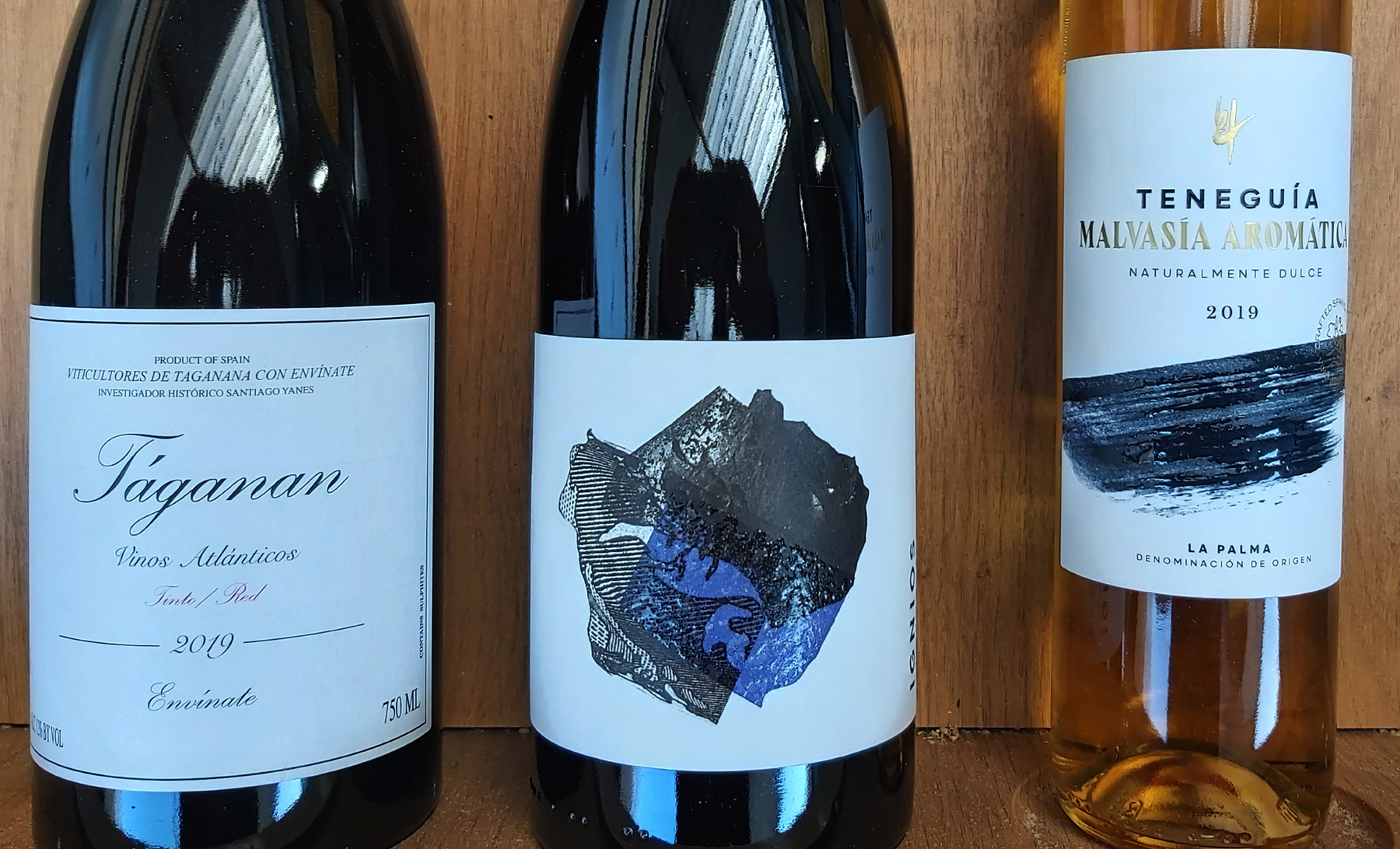 1 Tajinaste Blanco Seco 2019, 13%, £15.90.
1 Tajinaste Blanco Seco 2019, 13%, £15.90.
http://www.lescaves.co.uk
This fresh young wine is made from the dominant grape in the Canaries, Listàn Blanco (Palamino Fino), grown in the north coastal region of Tenerife and blessed by trade windblown cloud cover reducing heat and bringing moisture as it condenses. These combined makes for a long growing season with a late harvest in October. The wine has been made by Agustin Garcia Farrais, using 90% Listàn Blanco with 10% Albillo Criollo. Here it is harvested by hand into small boxes to prevent bruising and while most of it is vinified in stainless steel a small proportion is aged for around 3 months in French oak to round off the palate. It has a light, pale straw-yellow colour while, on the nose there are clear notes of lemon and lime citrus, pear, green apple and a hint of camomile and pineapple. In the mouth there is a well-balanced fresh citrus acidity, green apple, with a touch of fennel and pineapple and a floral aftertaste. There is a crisp mineral edge with some tasters detecting a fino-like saltiness.
2 Vidonia, Suertes del Marques, Valle de la Orotava, Tenerife 2019, 12.5%, £39.95.
http://www.vincognito.co.uk
This is a different style of wine made from the same Listàn Blanco grapes with the vines trained on a braided long woody cord system with each vine having seven branches 15m long making a braided cord, each vine having four or five cords which produce a lot of fruit on rocky volcanic and basaltic soils, between 350-450m. Although plenty of fruit there are not many vines because of their size. Each of the 100+ year old vines on this volcano in the Atlantic Ocean inevitably produces a more complex wine influenced by its rocky, wind-battered, warm moist maritime location. Although made from the same grape as the first wine this is fermented in used 500-litre barrels, with 11 months on the lees, it has a deeper more golden yellow colour and lacked the fresh citrus nose. Each plot is vinified separately with every barrel assessed by tasting before the final blend is assembled. Tasters reported citrus on the nose, perhaps a reductive character, flor-like yeasty notes were mentioned too. Good mouthfeel with tangy acidity (harvested early to keep the acidity), tart, saltiness evident, hints of smoke. Great balance and depth of character and drinking well now but has the structure to age well perhaps to 2024. Pair with oysters, lobsters, pork ribs, seawater boiled new potatoes with a spicy sauce.
3 Bermejo Malvasia Volcanica Seco 2019, 13.5%, £18.99.
http://www.wineshoplanzarote.com
This young wine comes from vines of the Canary Island’s most northerly and most easterly vineyard on Lanzarote. The farming landscape was dramatically changed during eruptions 1730-1736 when the area was covered in volcanic ash (small black gravel). After the eruptions, the farmers, unable to grow their original crops, planted two or three vines in pits 3 metres deep dug in the ash deep enough to establish the roots in the clay layers beneath. The low-density planting of vines in the pits with low semi-circular walls to provide shelter from the strong winds with the black gravels retaining heat brought new opportunities for the farmers. They planted the unique Malvasía Volcánica grape, a cross between Malvasia Aromatica and Marmajuelo. Only stainless steel is used in the winemaking producing a clean, bright pale-yellow wine with an aromatic nose of floral blossoms, stone and tropical fruits combined with a hint of citrus lemon and green apple freshness. On the palate peach, tropical and citrus fruits with a good level of acidity with typical Lanzarote minerality (saltiness). The small amount of residual sugar is balanced by the acidity, good mouthfeel and a long finish. A different and popular wine amongst the tasters. Pair this wine with grilled white fish or enjoy on its own. Drink young.
4 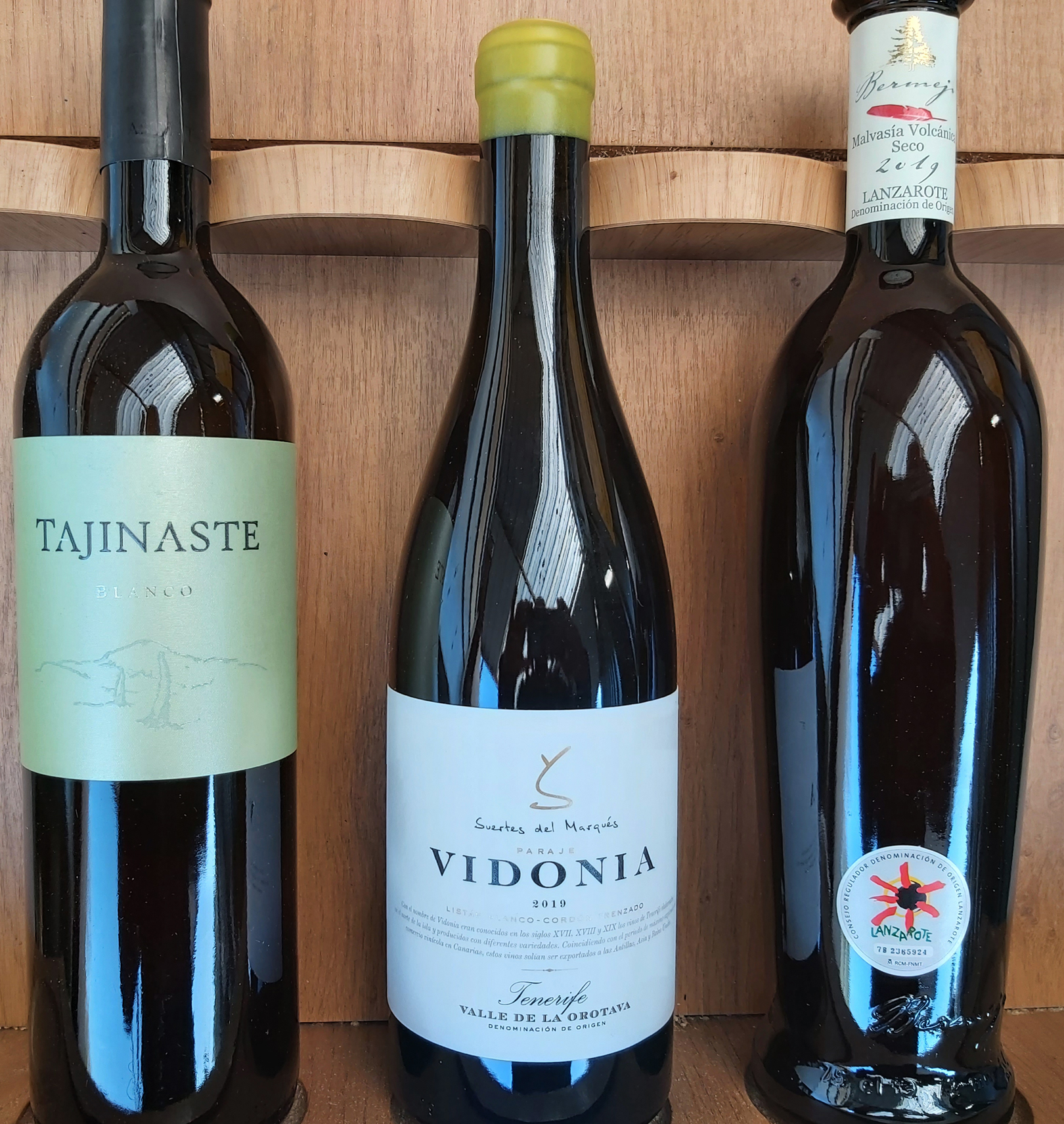 Envinate Taganan Tinto, Tenerife 2019 12%, £26.50
Envinate Taganan Tinto, Tenerife 2019 12%, £26.50
http://www.vincognito.co.uk
From the extreme northeast of Tenerife. The Envinate’s equivalent of a ‘village’ wine from local plots but there are also various other plots around Tenerife, but this wine is a local blend of (among other things) Negramoll, Listán Negro, Listán Gacho, Tintilla, Baboso, Sumoll, Malvasía Negra and Moscatel Negro. It has a thin translucent pale cherry colour and light body, medium tannins with fresh black cherry, cranberry, strawberry, crushed black and white pepper, sweet and tart fruits, mineral nose and earthiness on the palate. This wine smells of Tenerife! Drink these lighter bodied wines chilled. Food friendly with local dishes including goat stews and fish. Now->2025. It ages well.
5 Baboso Negro “Ignios Origenes”, Borja Perez Viticultor, Tenerife 2017 14.5%, £42
http://www.vincognito.co.uk
This wine comes from one of the smallest appellations in the Canaries. It is made from the Baboso Negro grapes grown on the north western side of Tenerife in the vineyard of Ycoden-Daute-Isora. The Baboso Negro grape was only rediscovered as recently 2000 and recognised as being capable of producing premium quality powerful wines with fresh succulent sweet fruit, filling the mouth with fresh floral cherry and other black fruits, pomegranate and a little nutty oak, balanced with a lean complexity including pepperiness, charred-wood smokiness and salinity. The Baboso Negro grapes were harvested at peak ripeness from a single vineyard with 20-year-old vines planted on clay-loamy soils. 30% of the grapes were whole bunch fermented without crushing. Cold maceration for 48 hours followed by stainless steel fermentation. After pressing, the wine was racked and matured in a 1,500-litre oak foudre (possibly new oak) and in one used 600-litre French oak barrique. Barrel maturation lasted 12 months and the wine was not stabilised or filtered. Tasters were evenly divided between those liking this wine and those not. Certainly dark red fruits. Some reported popcorn, floral notes, others burnt rubber (in a good way) or mustiness. The jury is out for the moment but this wine has the potential to evolve further with more time. It has plenty of fine-grained tannins that might benefit from a little more time in bottle. Drink now->2024.
6 Teneguia Malvasia Aromatica Dulce 2019 16%. Unfortunately, not currently available.
Imported by the club through Santo Bains especially for this tasting. Thank you!!
A rather special treat here and favourite wine of the evening by popular shoutout-vote. A late harvest grape wine from a producer in the south of Isla de La Palma specialising in sweet wines made with Malvasia Aromatica grapes. This is probably one of the wine styles referred to in Shakespeare’s Henry IV Part 2.
A naturally sweet wine made from grapes hand harvested during three sweeps of the vineyard yielding a luscious wine with an intense orange-golden colour, amber and bright with ripe mango and dried apricot fruit floral notes, honey, bitter orange, barley sugar flavours balanced by a high level of acidity. 80g of natural residual sugar / litre. It is fermented in stainless steel tanks to preserve these primary fruit aromas and flavours. Naturally sweet with a naturally high level of alcohol. Warming with a long finish. Best served 9-10oC if you can find it – please let me know if you do.
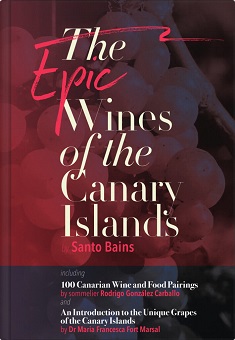 Santo’s background as a corporate geologist and researcher has uniquely given him an understanding of the potential of the underlying Canary Island geology for producing premium quality wines and he is now an authority on this unique terroir and its wines. Santo generously provided all participants with a hard back copy of his beautifully illustrated, encyclopaedic book The Epic Wines of the Canary Islands. Thank you Santo – a great read and companion on every trip to the Canary Islands.
Santo’s background as a corporate geologist and researcher has uniquely given him an understanding of the potential of the underlying Canary Island geology for producing premium quality wines and he is now an authority on this unique terroir and its wines. Santo generously provided all participants with a hard back copy of his beautifully illustrated, encyclopaedic book The Epic Wines of the Canary Islands. Thank you Santo – a great read and companion on every trip to the Canary Islands.
The Club members present unanimously agreed that Santo had given us an in-depth summary of the history, geology and climate of the Canary Islands and demonstrated the diversity and potential of this comparatively small, but incredibly diverse wine producing area, to produce wines keenly sought after for niche markets in fine restaurants around the world. The wines were striking and intensely memorable expressions of the terroir and indigenous grapes, each displaying to a greater or lesser extent the smoky, mineral, and salty characteristics of the volcanic islands from which they come.
Clive Manvell
19 May 2021